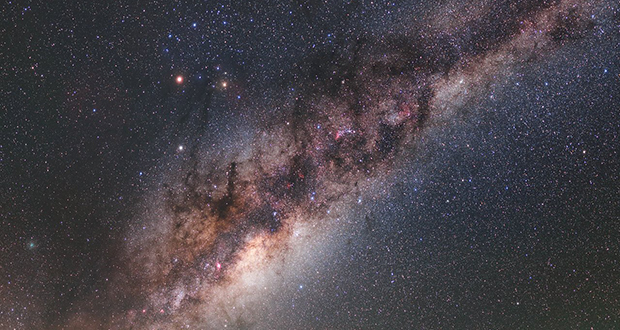26Diamond Star

There is a star about 50 light-years from Earth in the constellation Centaurus (BPM 37093) that is comprised of pure crystallized carbon, which means it is a diamond that weighs 10 billion trillion trillion carats.
27. Jupiter has a moon named Mneme. With a mean diameter of 1 km, its elliptical orbit is opposite to Jupiter's rotation and takes 620 days to orbit around Jupiter. Mneme means "memory" and is named for one of the Muses, or daughters of Zeus
28. The dwarf planet Chiron in our solar system which orbits our sun between Saturn and Uranus has its own rings. The orbit of Chiron is highly eccentric, which makes scientists speculate it may have originated from outside our solar system.
29. Ganymede, the largest moon in our Solar System, is the only known moon that has a magnetic field.
30. Mercury is thought to be the almost-exposed core of a planet that was 4.5x bigger before a collision with another proto-planet that blew away most of its crust and mantle.
Latest FactRepublic Video:
15 Most Controversial & Costly Blunders in History
31Laniakea

Our galaxy (the Milky Way) is part of a larger supercluster of 100,000 galaxies named Laniakea that stretches 500 million light-years across!
32. In the future when our sun becomes a red giant, Saturn's moon Titan will become warm enough for life to possibly evolve in a manner similar to Earth. These conditions would persist for a hundred million years.
33. The coldest place recorded in our Solar System is Triton, a moon of Neptune, which has a temperature of -240C (-400F).
34. Saturn has a moon called Mimas. It is really peculiar in that it has a large crater in it that makes it look like the Death Star.
35. The average number of stars we can see with the naked eye is around 10,000. This number is only the 0.000004% of all stars in the Milky Way galaxy.
36SGR 1806-20

When a magnetar star named SGR 1806-20, which is on the other side of our galaxy, experienced a "star-quake", in one-tenth of a second, a flare was released which had more power than what our sun can produce in 150,000 years.
37. There is a nebula called Gomez's Hamburger that looks like a space burger. The buns are light reflecting off dust and the patty is a dark band of dust in the middle.
38. The moons of Saturn Janus, and Epimetheus change orbits once every 4 years. Due to gravitational interaction, the inner moon's momentum increases as the outer moon's momentum decreases.
39. Since the planet Neptune was first discovered in 1846 it has only orbited the Sun once, due to the fact its orbit is about 165 years.
40. The neutron star 'PSR J1748-2446ad' rotates on its axis 716 times per second and is the fastest spinning known neutron star. At its equator, it spins at 24 percent of the speed of light.
41Callisto

Callisto (one of Jupiter's moons) has about 99% the diameter of the planet Mercury, but only about a third of its mass.
42. The orbit of Mercury follows a unique pattern different from other planets which remained unexplained until Einstein’s theory of bending space-time due to large nearby gravitation. Previous theory was there was another planet between mercury and the sun, Vulcan.
43. From the time Pluto was discovered until the time it was demoted from planethood, it still hadn't made one complete revolution around the sun.
44. Uranus is the only planet named after a Greek god instead of a Roman one. If it had been named after the equivalent Roman god, we would have called it Caelus.
45. Mars’ moons, Phobos and Deimos orbit in opposite directions along the equator. To an observer on the surface, the moons would appear to track in opposite directions, and both moons would vanish behind the bulge of the planet at certain latitudes
46Tadpole Galaxy

The Tadpole Galaxy is a spiral galaxy with the distinct feature of having a 280,000 light-year long trail of stars that resemble a tail.
47. On Europa, one of Jupiter's moons, the ocean is 62 miles deep meaning you could fit seven Mt. Everest(s) one on top of the other inside it. The deepest part of our ocean, Marianas Trench, can only fit one with 2 miles to spare.
48. The north pole of Mars is surrounded by a flat and featureless lowland, several kilometers lower the mean height of the planet, called Vastitas Borealis.
49. Saturn's moon Iapetus, which was discovered in 2007 was found to have a unique equatorial ridge that has peaks up to 8 miles (13 km) high that only exists in the dark region of the moon. There is no definitive explanation for how it formed.
50. A day on Saturn is equal to 10 Hrs 33 Min and 38 Seconds (10:33:38) whereas 1 year on Saturn = 29 Earth Years according to the new analysis of Cassini data.



